介绍
Imagine dragging your luggage and shuttling through the busy 飞机场 hall, facing complex flight information, gate changes and various service facilities. It would be a mess if there was no clear and fast guidance!
Fortunately, the LED显示屏 is like a smart and considerate “little assistant”. It can not only update information in time but also tell you where to go and what to do in the most intuitive way.
Today, let’s take a look at how this “little assistant” makes airport information guidance more efficient and convenient!
目录
1. Application of LED display screens in airport information guidance
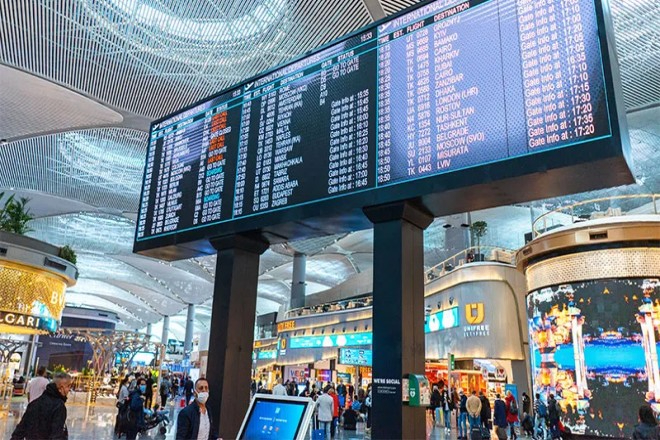
1). Flight information display
In the airport, the LED display screen is like an “information housekeeper”, updating the latest flight dynamics at any time.
Key information such as flight number, departure time, boarding gate, and boarding status (such as whether you are boarding, whether there is a delay, and whether the flight has been canceled) can be seen.
Moreover, this information is displayed in a table form, which is clear at a glance, and passengers can quickly find the flight they are concerned about.
What’s more considerate is that it will use different colors to distinguish the flight status: green means that the flight is normal and you can board the plane with confidence;.
Red is a reminder that the flight is delayed; yellow means that the boarding gate has changed and passengers have to go to the new boarding gate quickly.
In this way, passengers can quickly judge the flight status based on the color and have a good idea in mind.
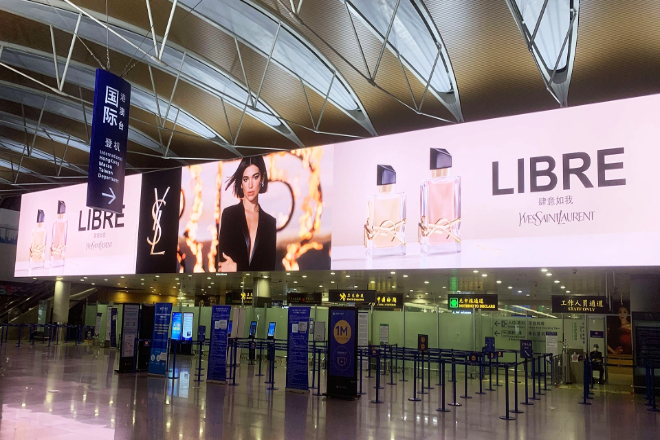
2). Boarding gate guidance
The airport is very large, and it is easy for passengers to get lost. At this time, the LED display screen comes in handy.
Display screens are installed everywhere in the airport to tell passengers the location, distance, and approximate walk time to the boarding gate.
If passengers don’t know how to get there, the display screen will also combine the airport floor plan to show the shortest route from the current location to the boarding gate in the form of animation.
For large airports, multi-level guidance screens will also be set up to tell passengers the approximate direction first and then guide them step by step to the specific boarding gate.
In this way, passengers will not go around in circles in the airport and can find their boarding gate faster.
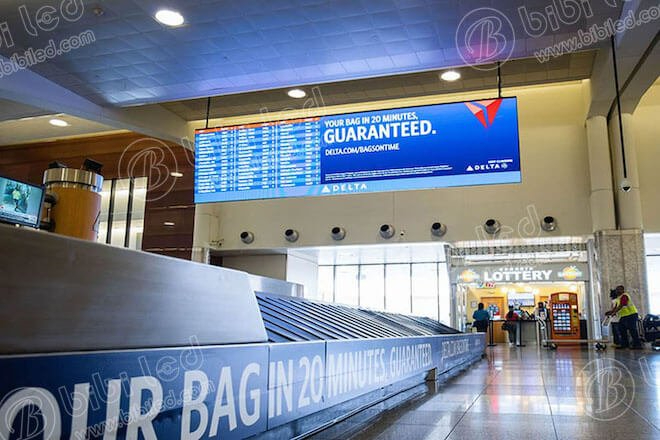
3). Baggage check-in information
Checking in luggage is an important part of taking a flight, and the LED display screen also helps a lot here.
It will show the baggage check-in process in detail, such as what cannot be checked in, and what are the size and weight limits of the luggage. Passengers can clearly understand these rules before checking in, avoiding unnecessary trouble.
Moreover, the display will tell passengers where the checked luggage will go, such as the location of the baggage claim carousel and when they can get the luggage.
Transit passengers will also be reminded of the relevant information and operation steps of luggage direct check-in so that passengers do not have to worry about luggage problems when transferring.
4). Airport service facility guidance
There are various service facilities in the airport, such as restaurants, shops, lounges, toilets, and baby rooms.
The LED display is like a “caring guide”, which can not only tell passengers the location and distance of these facilities, but also display the business hours.
What’s more, it can also provide personalized recommendations based on the needs of passengers. For example, if the passenger’s flight takes off at noon, the display will recommend some restaurants suitable for lunch.
If the passenger is with a child, it will recommend the nearest baby room. In this way, the passenger’s experience at the airport will be more comfortable and convenient.
5). Emergency information reminder
The most feared thing in the airport is encountering an emergency, such as a fire, earthquake or bad weather.
At this time, the LED display will immediately switch to “emergency mode” to display the emergency evacuation route, the location of the emergency exit, and the emergency rescue phone number.
In addition, in order to make everyone pay attention to this information, the display will use particularly eye-catching text, sound and flashing lights to remind passengers. In this way, passengers can quickly find a safe place in an emergency and ensure their own safety.
2. The advantages of LED display screens in improving the efficiency of airport information guidance
In the airport, flight information and boarding gate changes cannot be sloppy.
In the past, relying on manual replacement of signs or broadcast notifications, sometimes the information update was slow, and passengers were likely to miss important information.
Now with LED display screens, airport operation data and display screens are directly “connected online”, and flight information and boarding gate changes can be instantly updated on the screen.
Passengers always see the freshest and most accurate information without worrying about being in a hurry due to information delays.
The LED display screen displays information in a particularly “smart” way, with pictures and texts, and can also use animations for demonstration, which is much more intuitive than simple text or voice broadcasts.
For example, the boarding gate guidance path is displayed in an animated form, so passengers know how to get there at a glance.
There is no need to worry about getting lost because of incomprehensible text instructions, nor will there be any risk of missing a flight because of incomprehensible information.
This intuitive display method makes information transmission more efficient and worry-free.
LED display screens can be seen everywhere in the airport, including the waiting hall, security check channel, and bridge… These key locations are available.
No matter where passengers are in the airport, they can easily see relevant information.
Moreover, compared with broadcasting, the information on the LED display screen will not be disturbed by the surrounding noise, and the dissemination is more stable and reliable.
Passengers don’t have to worry about missing important information, and they feel more at ease.
LED display screens can also “serve dishes according to people” and push exclusive information based on factors such as passengers’ flight information and membership level.
For example, first-class passengers can receive guidance information for exclusive lounges, and transfer passengers will receive reminders of boarding gate changes for connecting flights.
This personalized service makes passengers feel cared for and makes the airport service warm.
The airport is an international place with passengers from all over the world.
The LED display supports multiple language displays and can automatically identify passengers’ language preferences or allow passengers to manually switch languages.
In this way, no matter which country the passengers come from, they can easily obtain information without worrying about language barriers. There is no need to worry about being in a mess at the airport because of language barriers.
3. Technical implementation of LED display screens in airport information guidance
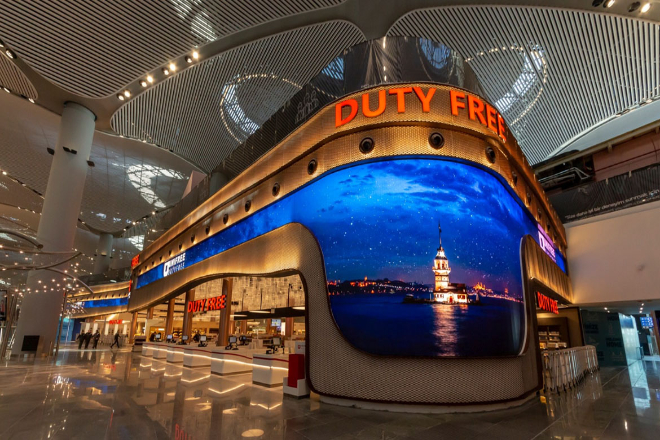
1). Data integration and transmission
There are all kinds of information in the airport, such as flight dynamics, passenger information, security inspection status, etc., which must be transmitted to the LED display screen in a timely manner.
To achieve this, the airport uses a high-speed fiber optic network, which is like an information “highway” that allows data to be transmitted quickly and accurately to each display screen.
Moreover, in order to prevent the information from being “sneaked” or tampered with, the airport also uses data encryption technology, which is like adding a lock to the information to ensure that the information seen by passengers is both timely and safe.
2). Display content management system
The LED display screen at the airport is not displayed randomly. There is a “commander” behind it – the display content management system.
This system can edit, review and publish various information, and can also quickly generate display content according to different scenarios.
For example, if the flight is delayed, the system will automatically update the boarding gate information; if there is an event at the airport, the system can also issue notifications in time.
Moreover, this system can also publish information regularly, automatically update it, and even manually adjust it. It is very flexible and can cope with various emergencies.
3). Intelligent interactive technology
In order to make it easier for passengers to find the information they need, some LED displays at the airport are also equipped with touch screens or gesture recognition technology.
Passengers can directly enter the flight number on the screen to see detailed flight information and boarding gate location and no longer have to ask people everywhere.
Moreover, these screens are also very “smart”. When passengers approach, they will automatically adjust the brightness and display angle to allow passengers to see more clearly, and the experience is superb!
4). Remote monitoring and maintenance
The LED display screens at the airport are widely distributed. It would be too troublesome to check them manually one by one.
Therefore, the airport uses a remote monitoring system, and the staff can see the operating status of each display screen in the office, such as display content, brightness, temperature, etc.
If the display screen fails, the system will automatically alarm and notify the maintenance personnel to repair it.
Moreover, many maintenance operations, such as software updates and parameter adjustments, can be completed remotely, greatly reducing the workload of on-site maintenance and improving efficiency.
Through these technologies, the LED display screens at the airport can not only transmit information in a timely and accurate manner, but also make it easier for passengers to obtain information, and also facilitate the management and maintenance of the airport.
4. Actual case analysis of LED display screens in airport information guidance
1). Bristol Airport, UK
Bristol Airport installed a huge LED display screen that was 14 meters by 2.5 meters in size. The screen is embedded in the entire wall to form a digital platform.
This screen is not only used to display flight information, but also to play advertising content to enhance the commercial value of the airport.
The case also won the “2017 DailyDOOH Best Fixed Installation LED Display Award”, showing its outstanding performance in airport information construction.
2). Singapore Changi Airport
The expansion project of Changi Airport T2 Terminal introduced a series of immersive digital experiences.
Among them, the “Digital Waterfall” consists of 892 LED screens, 14 meters high and 17 meters wide, simulating the scene of a waterfall pouring down from a high altitude with ultra-realistic details.
In addition, there is a “Digital Sky Immersive Garden”, which uses light and shadow technology to simulate daylight and weather conditions in real-time, changing from sunrise to a starry sky.
This screen is loved by tourists, and almost everyone who comes to this airport will come here to take pictures and “check-in”.
5. Challenges and coping strategies of LED display screens in airport information guidance
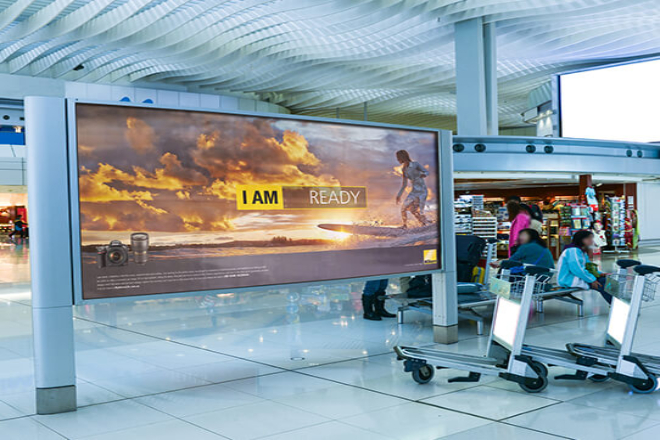
1). Rapid technological updates
The technology of LED display screens is developing too fast, and new display technologies (such as OLED and Micro LED) and interactive technologies are constantly emerging.
Airports must always pay attention to these new technologies and upgrade existing equipment from time to time; otherwise, the information guidance system will appear outdated.
However, upgrading equipment costs money, and you have to consider whether the new equipment is compatible with the old equipment. Otherwise, frequent equipment replacement will not only waste money but also cause trouble.
1.1). 应对措施:
The airport can arrange a small team to pay attention to the new technology trends in the industry.
Before deciding to upgrade the equipment, do good market research to see which technology is mature, cost-effective, and can be matched with the existing equipment.
Don’t rush to replace all at once. You can make a long-term update plan and do it step by step. This way, the pressure will not be so great.
2). Complexity of information management
The information sources in the airport are varied and the data formats are different. It is not easy to integrate this messy information and then display it beautifully on the LED display.
Moreover, the airport’s business is increasing, and the needs of passengers are becoming more and more complex. The information management system must be constantly optimized and upgraded, otherwise it will not keep up with the pace.
2.1). 应对措施:
The airport must unify the information standards and data interfaces within the airport so that the information output by each department is in the same format.
Hold more coordination meetings to allow more communication between departments to ensure that the information is accurate.
In addition, some advanced information management systems can be introduced to use big data and artificial intelligence technology to automatically classify and filter information and push relevant content according to the needs of passengers.
3). Diversity of passenger needs
Different passengers have different needs for information. Some passengers may only care about flight information, some may need to find restaurants or shops, and some may not be familiar with the facilities at the airport.
How to meet the needs of passengers of different ages, cultural backgrounds, and travel purposes is a headache.
3.1). Response strategy:
The airport can do more market research, listen to passengers’ opinions and feedback, and understand what they really need. Then adjust the content and format on the display screen according to these needs.
For example, provide a variety of display methods, including text, graphics, and videos, so that passengers can choose according to their preferences. In addition, a multi-language display can be set to facilitate foreign passengers.
4). Equipment maintenance and reliability
The airport environment is relatively complex, with a lot of dust, high temperatures, and various electromagnetic interference. LED display screens are prone to failure when they are operated for a long time in this environment.
Once the equipment breaks down, it will not only affect passengers’ access to information but may also delay flights.
4.1). Countermeasures:
The airport must establish a complete equipment maintenance system to regularly clean, inspect and maintain the display screen, just like maintaining a car, to discover potential problems in advance and deal with them in a timely manner.
When choosing equipment, try to choose products with reliable quality and strong anti-interference ability.
At the same time, a set of emergency maintenance plans must be prepared so that if the equipment breaks down, it can be repaired immediately to minimize the impact on passengers.
In short, although airports will encounter many challenges when using LED display screens for information guidance, as long as they respond reasonably, they can make passengers’ travel smoother.
6. 结论
The airport is a place full of busyness and expectations, and the LED display screen is like a “smart lighthouse” in the airport, illuminating the travel path of passengers.
From the accurate display of flight information to the rapid response to emergencies, from intimate, personalized services to barrier-free communication in multiple languages, the airport is more friendly and efficient in its own way.
最后,如果你想了解更多关于LED显示屏的信息, 请与我们联系。
